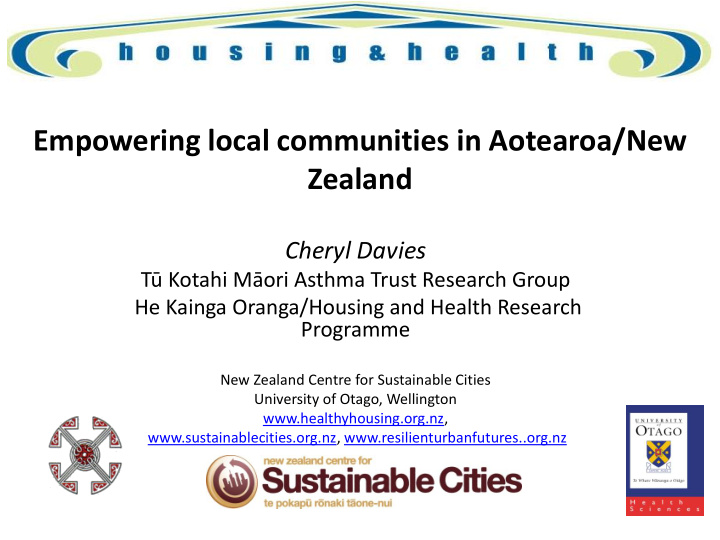



Empowering local communities in Aotearoa/New Zealand Cheryl Davies Tū Kotahi Māori Asthma Trust Research Group He Kainga Oranga/Housing and Health Research Programme New Zealand Centre for Sustainable Cities University of Otago, Wellington www.healthyhousing.org.nz, www.sustainablecities.org.nz, www.resilienturbanfutures..org.nz
Outline • Housing problems interconnected & require systems approach • Fuel poverty/energy insecurity affects quarter of households in NZ • Wellbeing framework enables broad outcome measures • Housing, energy efficiency programmes & community renewal important part of social & urban infrastructure
Aotearoa/New Zealand • Māori 15% population (4.8m) • Treaty of Waitangi (1840) marks relationship between Māori tribes & Crown which has ongoing responsibilities • Māori moved to cities after WWII • ‘Pepper - potted’ in state -provided public housing throughout suburbs • Accelerated loss of ‘ te reo’/language • Urban marae (pan-tribal) built as ceremonial and social meeting places in the cities • Growth in ‘papakāinga’/villages around marae
Indigenous urban design • Appropriateness of Māori models of pā & kāinga to social organization & urban limits • Plans for intensified suburbs with food production incorporated
He Tipu Manahau (a resilient plant) • Long-standing research relationships between community & researchers • Using community’s & researchers’ strengths to create a low-carbon model community: – Building affordable, high quality co-housing – Integrated renewable energy projects - solar PV & distributed energy – Reduce fuel poverty – Generate educational & employment opportunities – Showcase suburban regeneration
Importance of power relationships • Different parties to project, control different aspects of land building & community formation – Wainuiomata Marae Trust with Land Committee – Māori Land Court, rules on communal land – Hutt City Council returned extra land parcels – Te Puni Kōkiri – infrastructure costs – Kainga Ora - land development, building, landlord – Multi-disciplinary research team – community, engineers, building sector, public health, urban planners & multiple outputs – film, reports, articles. – Hutt City Council – Electricity sector’s involvement with solar panels • Cultural views valued & acknowledged in design
Importance of wrap around services • Working in collaboration with Takiri Mai Te Ata Whanau Ora Collective to deliver: – Kokiri Marae will deliver all health and social service support – Budgeting Services – Whai Oranga O Te Iwi Health Centre (Wainuiomata) – Tihei Rangatahi Programme (Wainuiomata) – Mana Wahine (Well Women services) – Naku Enei Tamariki (Parenting Support) – Well Homes (Housing Support) – Wainuiomata Marae (Cultural Support) – Kokiri Marae Maori Womens Refuge (Crisis Support)
Planning of medium-density housing around marae
Summary • Cultural, geographical & institutional proximity in Wainuiomata makes transactions between different sectors easier • Planning of both public & private space • Case study on marae reserve land can demonstrate benefits of systems approach in NZ medium-density houses around marae & kohanga reo • Coordinating funding from central & local government, Housing NZ, energy companies increases resilience & energy efficiency of solar- powered compact development
Recommend
More recommend